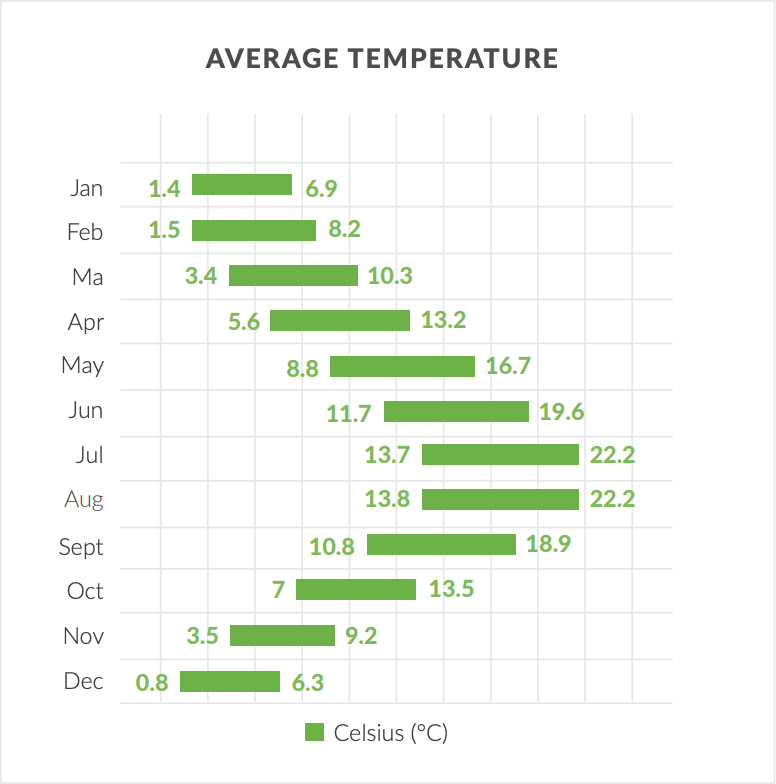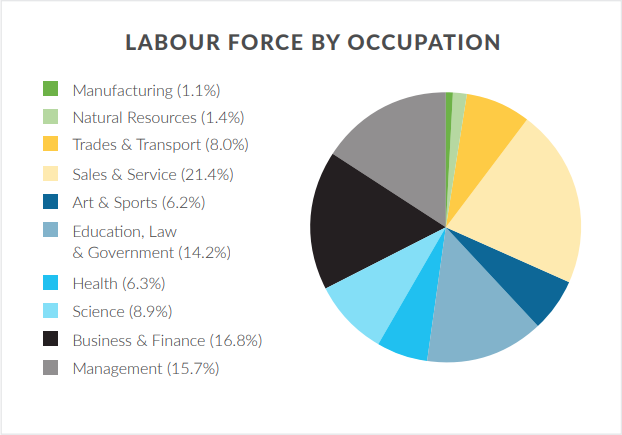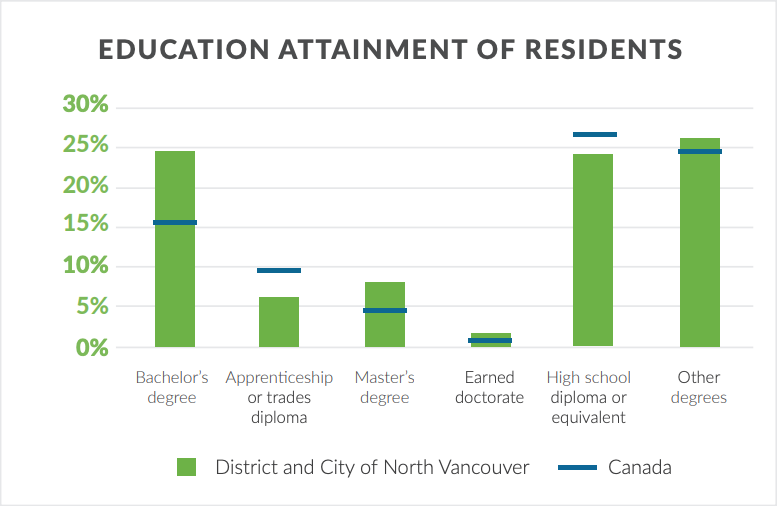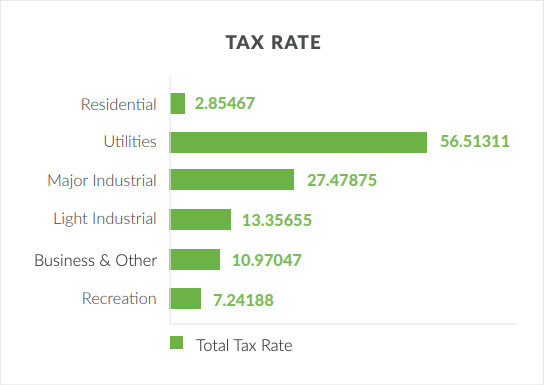Welcome to North Vancouver
Nestled between the coastal mountains and Burrard Inlet and home to acres of world-famous West Coast Rainforest, North Vancouver epitomizes British Columbia’s famed outdoor lifestyle.
North Vancouver is located on the unceded traditional territories of the Skwxwú7mesh (Squamish) and Səl̓ ílwətaʔ/ Selilwitulh (Tsleil-Waututh) Nations. The region remains home to the Squamish and Tsleil-Waututh Nations, as well as the City of North Vancouver and the District of North Vancouver.
In North Vancouver, you will find a strong business community, friendly people, a growing infrastructure, and a focus on a sustainable future. It’s the ultimate “work, live, play” community located a short SeaBus ride from downtown Vancouver, the second largest metropolitan area in Canada.
The region is committed to a green lifestyle through transportation and housing policies, efficient utilities, and sustainable business practices.
- Average yearly rainfall (mm): 1,699
- Average yearly snowfall (cm): 26
- Average temperatures: It is coldest in North Vancouver, B.C. in December when the temperature drops to 0.8 °C and warmest in July when it hits 22.2 °C.

LOCATION:
- Location: 49.32°N, -123.07°W
- Geographical size: 173 square kilometres
- Elevation: 108.73 metres • City of North Vancouver City is 12 sq km
- District of North Vancouver is 161 sq km
Our People
- Total population: 139,658
- According to Statistics Canada, the Aboriginal population was 2,510 in 2016, made up of 1,415 First Nations, 10 Inuit, and 960 Métis. The local Aboriginal population is the fastest – and youngest – growing population in Canada.
- Median age: 44.3 • Presently, there are around 21,400 people who will reach retirement in the next 15 years – the average age of retirement in Canada is 61.

POPULATION GROWTH:
- In recent years. the main source of population growth has been migration, with close to a 9% growth rate.
- The overall population grew by 1,523 people, an average growth rate of 0.36%, from 2011 to 2016.
- The 10-year projections (2018-2028) for the region foresee positive population growth of just over 2% – a slower rate of growth compared to the metro Vancouver region, which is predicted to grow at a rate of over 11%.

HOUSEHOLDS:
- Most popular dwelling size: 4 or more bedrooms
- Least popular dwelling size: 1 bedroom or less
- 41.6%, which is the majority of homes in North Vancouver, B.C., have 4 or more bedrooms. Homes with 3 bedrooms are also very popular, with 9,010 homes built with this number of bedrooms. The third largest category of homes according to a number of bedrooms are 2 bedrooms representing 19.76% of dwellings.
- Median 3 bedroom housing price: $1,198,000
- Median 3 bedroom apartment price: $998,000
- Median household income: $103,981 per year

Workforce and Industry
- Total Labour Force: 78,675 • Resident Workforce: 71,365
- Labour Force Participation Rate: 69%
- Employment: North Vancouver contains 80 jobs for every 100 employed residents. In other words, it is a net exporter of 20% of its workforce. As a result, local businesses who offer local jobs and shorter commutes create attractive opportunities for residents.
- Employment rate: 65%
- The sales and service sector employs 17,800 resident, the business, finance, and administration sector employs 13,140 residents, and 11,245 residents hold management positions.
- The most concentrated occupations are in management, art, culture, recreation, and sport.
- The fastest growing occupations between 2011 and 2016 were in arts and recreation, and in manufacturing and utilities. Natural and applied science occupations are a strong and growing labour pool as well.
- Business Sizes: 69.6% of North Vancouver businesses have fewer than 4 employees, and 97.9% employ 49 staff or less.



Educational Attainment
- 47% of North Vancouver residents age 25 to 64 years hold a university certificate, degree, or diploma at a bachelor level and above. This is substantially higher than the metro average of 37.5% for post-secondary attainment.
- Residents in the region of North Vancouver frequently attend post-secondary school – 24.5% of the population hold a Bachelor’s degree, which is 9% higher than the rest of the population of B.C.

Transportation
- North Vancouver is connected to the rest of the region through road, rail, sea, and air. 33% of commuters travel to work within the region, while 58% travel outside the region.
- YVR airport is only a 35-minute drive away and the Abbotsford International Airport is a 45-minute drive away. • The Trans-Canada Highway runs across North Vancouver, connecting the region to Whistler and to the ferries that travel to Vancouver Island, the Sunshine Coast and Bowen Island.
- North Vancouver is connected to Vancouver by two bridges: the Lions Gate and the Ironworkers Memorial, both spanning the Burrard Inlet. There is also a passenger ferry, the Seabus, which crosses the Inlet in just 12 minutes.
Getting around North Vancouver:
- Translink buses travel over land and sea
- E-bikes Share Pilot Project: City of North Vancouver council unanimously voted to support an e-bike program in November of 2018.
- Car Shares: Evo & Car2Go

Utilities
- North Vancouver strives to ensure a business-friendly tax environment, while offering high-quality infrastructure and services to support the needs of the economy. Both the District and the City of North Vancouver offer competitive tax rates for business and industrial classes.
- Electricity service is run by BC Hydro.

- Natural gas basic rates: Natural gas is provided by FortisBC. In North Vancouver, there is a local provider of dependable, clean, and competitively priced energy: The Lonsdale Energy Corporation.

Taxes
- Federal general corporate tax: 15%
- Federal M&P corporate tax: 15%
- Federal small business corporate: 10%
- Federal investment corporate tax: 15%

Sources:
www12.statcan.gc.ca/census-recensement/index-eng.cfm
www.canadianrealestatemagazine.ca/top-neighbourhoods/north-vancouver-bc-23564.aspx
www.nsnews.com/news/city-of-north-van-plugs-into-e-bike-pilot-program-1.23503196




